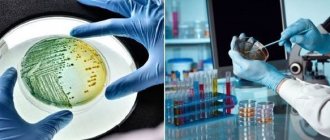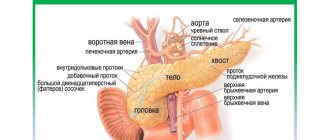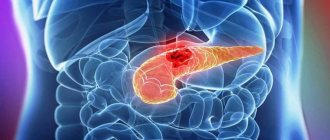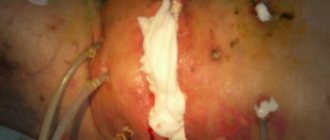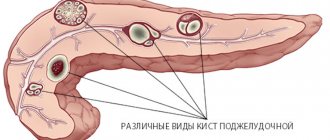Among all diseases of the gastrointestinal tract (GIT), the incidence of chronic pancreatitis ranges from 5.1 to 9%, and in the last few decades, the incidence of pancreatitis in our country has doubled1.
Chronic pancreatitis is an insidious disease, largely due to its recurrent nature. Patients are often concerned about periods of exacerbation, accompanied by severe pain, nausea, and vomiting.
Where does chronic pancreatitis come from? What causes the disease and is it possible to fight it? Let's try to figure it out.
Symptoms of chronic pancreatitis
Symptoms of chronic pancreatitis may vary depending on the stage (remission or exacerbation), course and physical condition of the patient. The main signs of the disease are as follows:
- acute pain without clear localization. Pain can be felt in the right hypochondrium, upper or middle abdomen and spread to the back. In many patients, pain occurs immediately after eating, especially if the diet contained fatty, smoked or spicy foods;
- frequent loose stools are one of the main signs of indigestion. Digestive problems in chronic pancreatitis are caused by a lack of enzymes;
- heaviness in the abdomen, nausea, which also indicate a lack of digestive enzymes;
- increasing feeling of hunger, muscle tremors, weakness, cold sweat;
- intoxication, manifested in fever, chronic fatigue, and a feeling of general malaise.
Remission: softer diet
After the period of exacerbation has passed, patients are transferred to a less restrictive diet. Stewed and oven-baked dishes are added.
This diet includes a high protein content, a normal amount of fats and complex carbohydrates, but “fast”, easily digestible carbohydrates (sugar, honey, flour products) are severely limited. Dietary supplements containing methionine, vitamins B1, B12, choline, lecithin, etc. are recommended. The diet is enriched with dietary fiber, ascorbic acid, and calcium.
Chemical composition:
- proteins: 110-120 g, including animals 45-50 g;
- fats: 80-90 g, including vegetable fats 30 g;
- carbohydrates: 300-350 g,
- dietary fiber (fiber): 25-30 g.
Energy value 2080–2690 kcal.
The principles of dietary nutrition during the remission stage should be followed for as long as possible, ideally throughout life.
Causes of chronic pancreatitis
One of the most common causes of chronic pancreatitis is poor diet and unhealthy lifestyle. Constant overeating, abuse of fatty foods and alcohol cause blockage of the excretory ducts of the pancreas.
Narrowed excretory ducts provoke the accumulation and premature activation of digestive enzymes. As a result, the pancreas actually begins to digest itself, and inflammation forms1.
In addition, the following factors can lead to chronic pancreatitis3:
- ulcer of the duodenum, stomach and enteritis. Chronic inflammation of the mucous membrane of the gastrointestinal tract makes it difficult to secrete pancreatic juice, which often causes chronic pancreatitis;
- cholelithiasis. After leaving the gallbladder, the stone causes blockage of the common duct and inflammation of the pancreas develops;
- genetic predisposition;
- toxic effects of drugs.
Pancreas - structure and main functions
Pain in the pancreas brings severe torment
The pancreas is an organ of the digestive system located behind the stomach on the back wall of the abdomen. It is characterized by a peculiar shape, has a head, body and tail. The length is 16-22 cm, and it weighs about 80g.
The gland has an alveolar-tubular structure. It is divided into grayish-pink lobules, each of which consists of glandular tissue and has its own system of excretory ducts. These small excretory ducts are connected to larger ones, which, in turn, are combined into a common excretory duct. The common excretory duct runs along the entire length of the organ and opens into the duodenum.
The lobules of the gland are formed from cells that produce pancreatic juice, rich in digestive enzymes. From the lobules, the secretion enters the duodenum through a common duct running along the entire gland. Between the lobules of the gland are groups of glandular cells, the so-called islets of Langerhans. These clusters of cells do not have excretory ducts; they produce insulin and glucagon directly into the blood. The gland has a mixed type of secretion, that is, it performs both endocrine and exocrine actions:
- The exocrine function is to participate in digestion. The gland produces pancreatic juice and carries it through the ducts into the duodenum. Every day, about 500-700 ml of juice is produced, which contains the enzymes necessary for digesting food - amylase, which helps convert starch into sugar; trypsin and chymotrypsin are enzymes responsible for protein breakdown; lipase, responsible for the breakdown of fat, etc. Thus, pancreatic juice is an important digestive juice necessary for the digestion of organic components of food.
- The endocrine function of the gland is to secrete glucagon and insulin, hormones involved in the regulation of carbohydrate metabolism.
The pancreas is in close relationship with other organs of the digestive tract. Any pathological process affecting it negatively affects digestion. Without the enzymes it produces, normal breakdown of food is impossible, and without the hormones glucagon and insulin, regulation of metabolic processes in the body is impossible.
Diagnosis of chronic pancreatitis
Identifying chronic pancreatitis can be difficult due to the nonspecific clinical picture. Nausea, abdominal pain, digestive problems - these symptoms are characteristic of many diseases, for example, stomach ulcers or chronic cholecystitis. Therefore, identifying the disease may require a whole range of studies. Diagnosis of chronic pancreatitis may include2,3:
- external examination of the patient. Chronic pancreatitis may be indicated by bluish areas of the skin on the front and side walls of the abdomen. In some patients, bright red patches of skin on the chest and back become noticeable. Palpation may reveal pain in the left hypochondrium and the upper third of the abdomen;
- a general and detailed blood test, which shows the presence of an inflammatory process, based on an increase in the concentration of leukocytes;
- laboratory blood test to identify markers of nutritional status;
- fecal elastase test;
- ultrasonography. In some cases, ultrasound examination (ultrasound) can be performed through the walls of the stomach and duodenum, which significantly increases the accuracy of the examination. This method is called endoUS and combines the possibility of endoscopic and ultrasound diagnostics of the gastrointestinal tract (GIT);
- computed tomography: used to determine complications of pancreatitis associated with thickening of the pancreas tissue.
University
Diseases of the gastrointestinal tract are not so terrible compared to those that the whole world fears (such as cancer and AIDS), and yet.
What is pancreatitis?
Gennady Kondratenko, Head of the 1st Department of Surgical Diseases of the Belarusian State Medical University, Doctor of Medical Sciences, Professor: The pancreas, in general, meets two tasks in the body, the most important, fundamentally very important tasks. This is the first thing - it is involved in the digestive conveyor, and the second thing is that it regulates blood sugar. Inflammation of the pancreas in acute or chronic form is called pancreatitis. It should be noted right away that the incidence of acute pancreatitis has a worldwide upward trend. The attention of the surgical community around the world, including our Belarusian surgical community, is focused on this disease. We see an increase in Belarus, including severe forms of pancreatitis, and we are concerned about this.
Gennady Kondratenko: “The incidence of acute pancreatitis has a worldwide upward trend. We see an increase in Belarus, including severe forms of pancreatitis, and we are concerned about this.”
Interesting fact. We are afraid of heart attack, stroke, cancer - the main leaders in mortality in the world. And we completely forget, or rather, we know little about such an insidious disease as pancreatitis.
Alexey Protasevich, Associate Professor of the 1st Department of Surgical Diseases of the Belarusian State Medical University, Candidate of Medical Sciences: We can say that this is even a fatal disease. Particularly acute pancreatitis is a potentially fatal disease.
Alexey Protasevich: “We can say that this is even a fatal disease. Especially acute pancreatitis is a potentially fatal disease.”
Due to its unpredictability and transience.
Alexey Protasevich: Dies somewhere in the range of 20-30% of cases.
So what is this monster that can take a person's life in the blink of an eye?
Alexey Protasevich: This is the death of pancreatic tissue.
It would seem that this is a very small organ - no more than 50 g of weight, and its disease can lead to the malfunction of other vital organs.
Alexey Protasevich: In the beginning, to improper functioning of the heart, lungs, liver, kidneys, and sometimes the brain. If detoxification is not done, your patient may die from heart failure.
Fortunately, this organ has one advantage. Let's face it: somewhat reassuring.
Alexey Protasevich: The pancreas is created with a large margin of safety. You can be missing 90% of your pancreas and not have diabetes or enzyme deficiency. Therefore, in principle, God created the pancreas seriously.
And to damage it, you have to try really hard.
Causes of the disease
Alexey Protasevich: For men, in the overwhelming majority of cases, the reason is drinking alcohol.
And in any form and in any quantity.
Alexey Protasevich: If a person drinks alcohol regularly and a lot, he will 100% develop cirrhosis of the liver.
And for the development of pancreatitis, a single dose is enough.
Alexey Protasevich: The so-called alcoholic excess can lead to the development of severe acute pancreatitis.
Alexey Protasevich: “The so-called alcoholic excess can lead to the development of severe acute pancreatitis.”
For women, the main cause of pancreatitis can be disease of the gallbladder and bile ducts. What is the connection, you ask? Yes, the most direct one.
Alexey Protasevich: Bile enters the duodenum through a duct that passes in the head of the pancreas. Just before entering the duodenum, the pancreatic duct merges with the bile duct.
Such anatomical proximity leads to the fact that the ill-fated pebbles also injure the pancreas, thereby causing pancreatitis in women. The insidiousness of the disease also lies in the fact that in some cases the cause of its occurrence cannot be established.
Alexey Protasevich: This is the so-called idiopathic pancreatitis. A number of reasons remain closed, since there is a connection with genes, with the patient’s congenital predisposition to developing this particular disease.
Alexey Protasevich: “A number of reasons remain closed, since there is a connection with genes, with the patient’s congenital predisposition to developing this particular disease.”
Fortunately, there are few such cases - about 10% of the total number of cases. So judge for yourself that in the overwhelming majority of cases the cause of the development of such an unpredictable disease is our very predictable actions. And that's a fact.
Chronic pancreatitis
Gennady Kondratenko: This is observed when small, long-term, repeated inflammations of the pancreatic tissue lead to degeneration of this tissue and the replacement of this functional tissue with connective scar tissue. Thus, the digestive function of the pancreas becomes weaker, digestive problems arise in these patients, moderate constant or periodic pain occurs in the upper abdomen, stool becomes upset, and diarrhea occurs. Such patients also need to be treated with replacement therapy, and they must always follow a diet. The reason for its development is the same: excessive consumption of alcohol, let’s say, and food, especially fatty and spicy food, well, and also carrying stones for a long time, cholelithiasis, which is not operated on in a timely manner. Then, when a person already has a chronic form of pancreatitis, does not pay attention to it, leads an unhealthy lifestyle, a picture develops that is almost completely identical to acute pancreatitis.
Gennady Kondratenko: “Then, when a person already has a chronic form of pancreatitis, does not pay attention to it, leads an unhealthy lifestyle, a picture develops that is almost completely identical to acute pancreatitis.”
Treatment
Gennady Kondratenko: I would like to note that this acute onset requires immediate delivery to the emergency rooms of those hospitals where there are surgical departments. Why a surgical hospital? Because after all, this is a surgical disease. In some cases, surgical intervention for this disease will be indicated. There are very severe forms of pancreatitis that can be treated in intensive care. The only wish, of course, is that they don’t go to the clinic, perhaps, because delays in providing assistance play a significant role in the further course of pancreatitis.
Patients with acute pancreatitis are most often admitted to the hospital in severe form for one simple reason - late presentation.
Anastasia Khatkovskaya, anesthesiologist-resuscitator: A day, two, some stay at home for a week, at best, they self-medicate, at worst, they do nothing. Many people abuse alcohol the day before and often don’t even remember the onset of symptoms.
Anastasia Khatkovskaya: “They stay at home for a day, two days, some for a week, at best they self-medicate, at worst they do nothing. “Many people abuse alcohol the day before and often don’t even remember the onset of symptoms.”
Perhaps these are the most common mistakes made by patients.
Yan Kernozhitsky, surgeon of the 1st emergency surgical department of the 10th City Clinical Hospital of Minka: We are used to doing everything “at random”. What if it goes away? You hear all this from probably 100% of those who arrived on the second or third day.
For many, this “maybe” costs their life.
Jan Kernozhitsky: We are losing time to start massive infusion therapy.
Therefore, once again about the symptoms.
Symptoms
Alexey Protasevich: The main clinical manifestation of acute pancreatitis is epigastric pain.
Or, as ordinary people say, “in the pit of the stomach.” The pain may radiate to the right or left hypochondrium. And, as a rule, it is encircling in nature.
Alexey Protasevich: “The main clinical manifestation of acute pancreatitis is epigastric pain.”
Alexey Protasevich: Further down the list there is nausea, vomiting, usually uncontrollable, then bloating, then general symptoms of intoxication in the form of tachycardia, shortness of breath, general weakness.
Unfortunately, acute pancreatitis can masquerade as other diseases.
Alexey Protasevich: Most often confused with gastritis and peptic ulcers.
Hence the late seeking of medical help and, as a consequence. decreased effectiveness of therapy.
Alexey Protasevich: “Most often confused with gastritis and peptic ulcers.”
Anastasia Khatkovskaya: A person comes in in a dehydrated state, because a very large loss of fluid occurs due to the inflammatory process that occurs in the abdomen, and blood thickening occurs. Therefore, the first aid that we provide as anesthesiologists and resuscitators consists of massive infusion therapy.
Often the infusion reaches 6-8 liters of fluid per day.
Anastasia Khatkovskaya: Without this, a person, in principle, within a day or two can go into intoxication shock and die.
Diagnostics
Here, in the intensive care unit, the simplest, but proven over the years, diagnostic method is performed - ultrasound.
Alexey Protasevich: If we are talking about severe cases, if we need to know all the information about the condition of the pancreas, this is, of course, computed tomography. Now there are works on magnetic resonance imaging. It appears to provide virtually the same amount of information as a CT scan.
If the patient’s body does not respond adequately to therapy from the first days of treatment or surgical intervention is planned, doctors use another diagnostic method.
Alexey Protasevich: So-called endosonoscopy. This is an endoscopy, but when a small ultrasound sensor is attached to the endoscope sensor. And we actually put the sensor through the duodenum onto the pancreas, and therefore we get very detailed information. a very reliable image of the condition of the pancreas.
Finally, a classic blood test.
Alexey Protasevich: For the purpose of increasing pancreatic enzymes in it. That is, these are the three signs of acute pancreatitis - the presence of pain, increased enzymes and ultrasound signs of inflammation of the pancreas.
Alexey Protasevich: “Three signs of acute pancreatitis are the presence of pain, elevated enzymes and ultrasound signs of inflammation of the pancreas.”
Anastasia Khatkovskaya: If the patient was admitted two days, three days after the onset of the disease, of course, it is no longer possible to interrupt the process. The process has been started, a cascade of pathological mechanisms has been launched.
Exacerbation of chronic pancreatitis
Chronic pancreatitis may hardly manifest itself until the period of exacerbation. Relapse of the disease is usually associated with two main reasons3:
- alcohol consumption. Even a small amount of alcohol consumed can provoke the transition of the disease into the acute phase;
- violation of the diet, overeating, a large number of fatty, fried, spicy dishes on the menu.
Other factors can also provoke exacerbation of chronic pancreatitis in adults, for example, chronic stress, physical fatigue, poisoning or the toxic effects of certain medications3.
Exacerbation of the disease is manifested by the following symptoms3:
- attack of acute or dull pain in the hypochondrium. Painful sensations spread to the subscapular region or the entire back;
- progressive diarrhea. In this case, the feces have a characteristic greasy shine. Undigested food remains are often observed in the stool;
- the occurrence of specific bitterness in the oral cavity, nausea and loss of appetite;
- whitish coating on the surface of the tongue;
- weight loss.
Exacerbation of chronic pancreatitis in adults can last for one to two weeks. You cannot fight the disease on your own during this period: the best solution is hospitalization and constant monitoring by specialists.
Surgery
The operation involves removing dead tissue and cleaning the abdominal cavity. Intervention is indicated if the patient has a total or subtotal infection of an infectious nature, a purulent abscess, false cysts, or peritonitis.
If the disease proceeds without infection, surgery is avoided.
Surgeons prefer to resort to minimally invasive techniques, since open abdominal surgery has a high mortality rate and is often accompanied by secondary infection.
Treatment of chronic pancreatitis
The answer to the question “how to cure chronic pancreatitis” remains open even for modern doctors. The treatment regimen is determined by the doctor for each individual case. The main thing is that therapy should be comprehensive, affecting the main cause of the disease.
Treatment of chronic pancreatitis includes2,3,4:
- immediate cessation of bad habits. Smoking and abuse of strong alcoholic beverages aggravate the inflammatory process and contribute to the subsequent development of the disease;
- strict adherence to the diet. The daily diet should contain high-calorie foods, without spicy foods, salt and pure sugar. You should eat food often, in small portions. In case of exacerbation of chronic pancreatitis, therapeutic fasting is prescribed, which will help stop pancreatic secretion and relieve pain. After 1-3 “hungry” days, the patient is transferred to a special diet;
- basic therapy. In this case, we are talking about taking the following type of drugs: antispasmodics and analgesics, antisecretory and detoxification drugs. Treatment is carried out under the supervision of a doctor with strict adherence to the instructions;
- taking enzyme preparations, the task of which is to compensate for the impaired functioning of the pancreas. The fact is that the pancreas does not recover (it is not the liver), and therefore will no longer be able to work at full capacity during chronic pancreatitis. That is why the first line of therapy is enzyme preparations, which should be taken for life. An example of an enzyme drug prescribed for chronic pancreatitis is Creon®;
- complex therapy. May include taking antispasmodics or analgesics, antisecretory and detoxification medications. Therapy is carried out under the supervision of a physician with strict adherence to the instructions;
- taking anti-inflammatory and painkillers that improve the patient’s well-being;
- herbal medicine, which can be prescribed during remission only as prescribed by a doctor.
What to do if an exacerbation of pancreatitis occurs suddenly, and the ambulance has not yet arrived? Before the doctors arrive, you need to lie down, try to relax your abdominal muscles as much as possible and apply a heating pad with cold water to the sore spot. You should not take painkillers or any other medications - this will interfere with correct diagnosis. And, of course, any food and drinks, even plain water, are strictly prohibited, because any food or liquid can cause increased pain3.
Epidemiology
The content of the article
According to recent studies, every 34 out of 100 thousand people develop pancreatitis every year, and due to the increasing prevalence of the main etiological risk factors - obesity, alcoholism, smoking, stone formation, the disease is diagnosed in younger people. Also, such statistics are associated with improved diagnosis and identification of less common causes of pancreatitis.
An independent risk factor for AP is smoking. This habit worsens alcohol-related damage to the pancreas.
Risk factor for pancreatitis is smoking
Most patients have mild pancreatitis; in 20-30% of cases, severe pancreatitis occurs. The mortality rate from severe pancreatitis is about 15%.
The drug Creon® 25000 for chronic pancreatitis
Find out more
Decreased pancreatic function inevitably leads to a lack of digestive enzymes in the body, so-called enzyme deficiency. As a result, the quality of digestion suffers, and the body does not receive the necessary energy and nutrients for full functioning. Creon® is designed specifically to compensate for the lack of its own enzymes through their delivery from the outside and belongs to the group of enzyme preparations. The drug contains enzymes identical to those produced by the pancreas. The key feature is that the active ingredient Creon® is small particles - minimicrospheres, which are collected in a capsule. The fact is that science has been studying enzyme preparations for more than 100 years in order to increase their effectiveness. To date, scientific advances indicate that preparations with particles whose size does not exceed 2 mm4.5 can most accurately recreate the natural process of digestion. Moreover, it has been scientifically proven that the smaller the particles of the drug, the more effective it can be4,6.
Creon® is the only drug whose capsule contains hundreds of small particles - minimicrospheres7. Their size does not exceed 2 mm, which is recorded as recommended in world and Russian scientific works4,5,6.
What else is important to know about enzyme preparations?
The minimum starting dosage is Creon® 25,000 units, which is stated in Russian recommendations for the treatment of chronic pancreatitis and exocrine pancreatic insufficiency2,5. The number indicates the amount of the enzyme lipase, which helps digest fats. If necessary, the doctor can increase the dosage; in European practice, the required dose per single dose can reach up to 80,000 units8. By comparison, the pancreas of a healthy person produces up to 720,000 of these units during each meal9.
Therapy should be taken seriously, since high-quality “nutrition” of the body is the key to its functioning. How long can a person live without energy from food? With chronic pancreatitis, the body must be supplied with enzymes at every meal, even with a snack. Thus, in accordance with the instructions for the drug Creon®, a full dose is required for a meal (for example, 25,000 units), and half for a snack. Creon® capsules are convenient to use: you can open them and add minimicrospheres to food, thereby selecting the desired dose10. More information about the admission rules can be found here.


